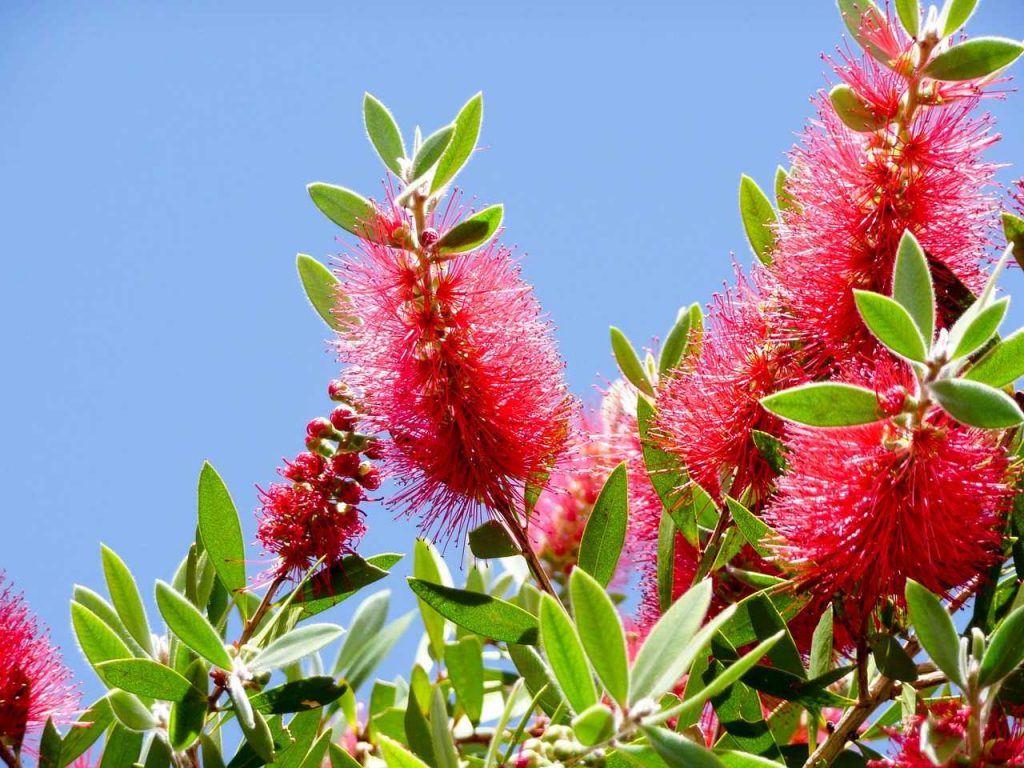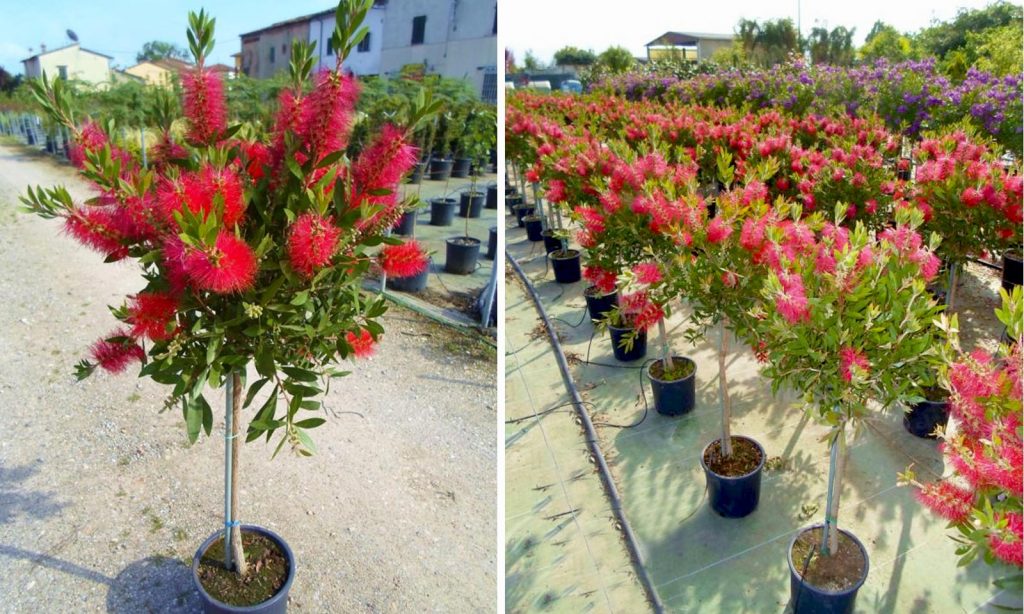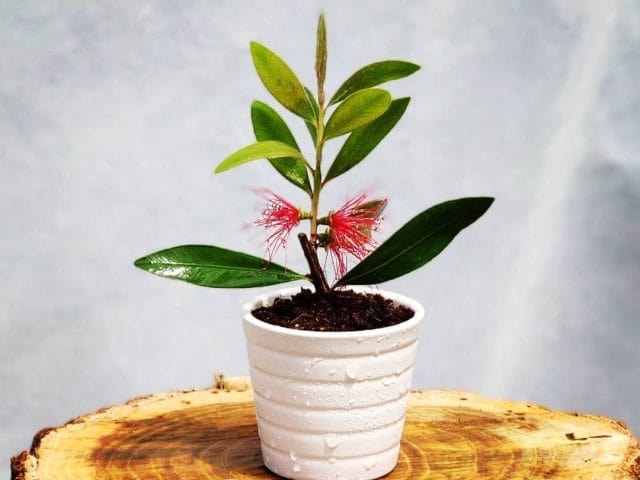The indoor giant, one of the original exotics, Callistemon or bottlebrush tree, is rare in our interiors. This plant is more suitable for winter gardens and greenhouses. And the reason is not only the requirements for an exceptionally cool winter.
But if conditions suitable for bottlebrush trees are found, it will be impossible to remain indifferent to the dark foliage, original silhouette, and unforgettable fluffy flowering. The extravagant appearance of this plant fully compensates for any difficulties in both the care and selection of the ideal place.
Table of Contents
Description of The Plant
Bottlebrush trees ( Callistemon Tree ) from the Myrtaceae family are one of the most extravagant exotics, in which everything is unusual – from shoots to foliage and flowering. These are medium-sized evergreen shrubs and trees from 50 cm to 3 m in height. Callistemon shoots are straight, even, and sometimes drooping, with rough, light, brownish, or whitish bark.
The leathery leaves are needle-shaped, lanceolate, spear-shaped or linear, pointed-spiny, up to 10 cm long with a width of only 1 cm. They grow unusually, in a spiral, somewhat reminiscent of conifers.
The rich dark green color of bottlebrush tree leaves is quite variable: young leaves – light, bronze, or reddish – darken with age. The strong aroma of Callistemon foliage is provided by glands along the entire surface, which actively release essential oils when rubbed.
The smell of Callistemons is reminiscent of tea tree or lemon and is often felt even with slight air movement around the bushes. Callistemon tree is one of the most valuable indoor phytoncides.
The Bottle brush tree blooms in the spring; under ideal conditions, repeated flowering is possible. Thanks to its special inflorescences, Callistemon received its bright nicknames – “bottlebrush tree”, “sparkler candle” and “red stamen”.
Small flowers with inconspicuous small petals grow at the top of the branches, forming a cylindrical raceme that looks like a fluffy brush. The most spectacular part of the flowers is the numerous glossy, large stamens, painted in the brightest shades – from typical red to white, pink, yellow, green, and purple. Sometimes leaves and flowers alternate, but each shoot always ends in a whorl of young leaves.
In place of the flowers, round woody capsules with seeds also begin to develop around the shoots, forming a cone. The inflorescences are considered not very decorative; they are most often simply cut off. To collect your seeds, the boxes are collected and stored in a warm place until they open on their own.
Types of Indoor Bottlebrush Trees

Different types of Callistemons easily hybridize with each other; indoor plants are most often varieties and decorative forms. The most common species is lemon callistemon ( Callistemon citrinus ), an evergreen shrub up to 3 m tall, with pointed-lanceolate leaves up to 9 cm long and 1 cm wide, a lemon aroma, and pink or red brush inflorescences up to 10 cm long.
The varieties differ mainly only in the color of the inflorescences – lilac, wine, raspberry, white, and pink. Other compact species are much less common.
Growing Conditions for Indoor Bottlebrush Tree
It is not so difficult to choose a place in the interior for a Bottle brush tree, especially if you move it to the garden for the summer. The main difficulty is that the flowering and health of the Callistemon tree are determined by coolness and sufficient light intensity during the dormant period.
Lighting and Placement
Bottle brush tree in nature prefers to grow in open, sunny places. Direct light on the sunniest, southernmost windowsill in the house is the ideal place for this plant in the interior. Callistemon is not afraid of direct rays even in summer.
It is also better to place it in well-lit areas when taking it out into the fresh air. For winter, it is better to add light to the Callistemon tree for up to 12 hours a day.
Temperature and Ventilation

For Bottle brush trees, it is necessary to provide cool conditions in winter, at temperatures from 10 to 15 ° C. Decreases below 7 degrees are unacceptable, but even in warm weather (above 16 degrees), plants quickly become stretched, become exhausted, suffer from pests, and not only do not bloom.
Like all Australians, Bottlebrush trees adore fresh air and cannot survive in completely enclosed spaces. They require frequent ventilation and free air circulation around the shoots.
The more plants spend outdoors or with a window constantly open, the better. In the summer, this exotic plant can be freely taken out into the garden or at least onto the balcony, monitoring the night temperatures.
Caring for Bottlebrush Tree at Home
Bottlebrush trees do not tolerate water stagnation, but they are also very poor at regulating the complete drying of the substrate. They need attentive, but quite ordinary care.
Watering and Air Humidity
The Bottle brush tree needs to be watered regularly, allowing no more than a third of the soil to dry out and immediately drain excess water from the trays. From October to February, watering is reduced during the dormant period, and the soil is dried more strongly, to half or almost to the very bottom. To water Callistemon, you can only use soft water.

With proper care, the Bottle brush tree adapts well even to dry air. In case of extreme dryness, for example, in the proximity of heating devices, heat, and dry air increase the likelihood of infection with spider mites. Care must be taken to stabilize the conditions by installing trays with wet moss and expanded clay.
Top Dressing and Fertilizer Composition
Fertilizer for Callistemon plant is applied in liquid form, along with water for irrigation, exclusively from spring to autumn.

Callistemons are sensitive to an excess of phosphorus and require the choice of universal, complex, organo-mineral fertilizers.
Trimming and Forming Bottlebrush Trees
The main pruning on Callistemons is carried out after flowering to restrain growth and stimulate branching, and lush flowering next year. In young plants, it is imperative to start pinching as early as possible. If the bushes stretch out or develop unevenly, you can correct them by pruning them down to half the length of the shoots.
If desired, you can cut the Bottle brush trees into strict contours or form them into a standard, exposing the central shoot and restraining the growth of lateral branches.
Transplantation and Containers
Even young bottle brush trees are replanted no more often than every 2 years, and for old bushes, replanting is carried out only when there is a physical need for it; roots begin to appear in the drainage holes.
Waiting for the roots to fill the space is the best strategy. In years when replanting is not carried out, the top layer of substrate (4-6 cm) needs to be replaced. Callistemon is rolled over, keeping the earthen lump intact.

The Bottlebrush requires the selection of large containers and is most often grown in tubs. But before reaching the maximum diameter, the pots are selected according to the size of the root system (Callistemon blooms more actively in cramped pots). Laying high drainage at the bottom ensures there are no problems with waterlogging.
The soil mixture for the Callistemon plant should be nutritious, but quite light, neutral, or slightly acidic (pH from 5.0 to 7.0). The optimal composition of the substrate is turf and leaf soil with sand in a ratio of 2:1:1. It is advisable to add baking powder to the substrate.
Bottlebrush: Diseases, Pests, and Problems

Most often, Bottlebrush trees with their narrow, spiny leaves suffer from spider mites, but other pests are also found on this plant – whiteflies, aphids, and mealybugs. It is better to control pests immediately with systemic insecticides.
All problems in the development of Callistemon are associated with warm wintering, insufficient lighting in winter, and violation of average soil moisture levels. When the substrate dries completely, the Callistemon leaves dry out and curl.
To “revive” the Bottle brush tree, in addition to normalizing watering, frequent spraying and feeding of the leaves are needed.

The tips of the leaves of the Callistemon plant dry not in dry air, but when there is a need for replanting, filling the space of the pot, or there is no room for the development of roots. But blackening of the tips occurs when there is too much shading or waterlogging.
Reproduction
The bottle brush tree is often grown from seeds. They need a standard spring or summer sowing with a light covering of 3-5mm of soil. With stable humidity, in bright light, under film or glass, and at room temperatures, Callistemon seeds germinate in just 1 month. Seedlings are very sensitive to root damage and fluctuations in soil moisture and dry out easily.

Varietal Callistemons are propagated by semi-lignified cuttings. Cuts must be treated in a growth stimulator, and rooting must be carried out in greenhouses, under a hood, maintaining a stable temperature of 20-25 degrees.
YOUR QUESTIONS ABOUT Callistemons
Q1: Why is the Bottlebrush tree not flowering?
From its southern origin, the tree retained its love for the sun. Lack of sun is a common reason why Bottle brush trees do not bloom. It refuses to bloom in dense shade; its exposure may not be sunny enough. This shrub blooms in late spring and then sometimes sporadically throughout the rest of the year.
It blooms best in soil that is not too dry, without excess limestone. Water it regularly during hot periods. Removing faded flowers stimulates the appearance of new ones.
Q2: Why are the Bottlebrush plant leaves dry after winter?

If all the leaves and small twigs were dry, the shrub probably did not survive cold spells and frosts. However, it can grow back from the root. Its cultivation in open ground is possible only in regions where winters are mild and the temperature does not drop below -8 °C.







